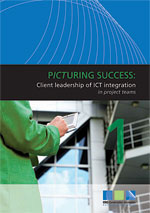by Graham Brewer
The research process for the PICTURING SUCCESS series
These guides are the result of a two-year project funded by the Cooperative Research Centre for Construction Innovation, titled Critical success factors for ICT-mediated supply chains. The project explored the factors considered by industry practitioners to be critical to the successful adoption of ICT, both within their firms and between their firms and their trading partners. It has harnessed the expertise provided by:
- previous research
- a panel of international experts
- a national postal survey of experienced practitioners from across the industry
- detailed case studies of projects using ICT.
These guides have a number of objectives:
(a) to identify the perceived effects and benefits experienced by firms using ICT
(b) to identify the level of ICT use
(c) to describe the operational environment within which ICT is typically deployed, and describe what form that ICT takes
(d) to describe the critical success factors identified by industry peers
(e) to examine their implementation through case studies
(f) to identify the barriers to ICT adoption experienced by industry peers
(g) to provide a self-assessment tool.
In the context of this project, critical success factors (CSFs) have been defined as those things that absolutely, positively must be attended to in order to maximise the likelihood of a successful outcome for the stakeholder, in the stakeholders terms.
Ultimately, readers will make business decisions about ICT investments and business process re-engineering on the basis of:
prior experience
persuasion by diverse evidence
alignment with strategic business goals
potential to increase profitability.
It therefore follows that these guides should adopt a persuasive, advisory stance, rather than suggest a panacea.
Four guides have been developed, each of which reflects an industry sector:
| | | |
1. Client leadership of ICT integration in project teams | 2. Head contractors driving ICT in project teams | 3. Consultants adding value through ICT in project teams | 4. Developing ICT agility for subcontractors ICT in project teams |
| | | |
Each guide is primarily based on the findings of the national survey, augmented by evidence from both the Delphi survey of experts and the case studies of specific project supply chains. Specific instances of best practice that were discovered during the case studies are included later in this guide. These are conveniently arranged in accordance with the CSFs derived from the research.
What do the guides contain?
Each sector-specific guide is arranged in the same way. It begins with a brief overview of the guide and the following sections:
Industry perspectives: This section describes the benefits, types and levels of ICT used either in your sector or across the industry. You will be able to identify your current level of ICT use whether it is low, medium or high compared with others in the industry.
Self-assessment tool: This provides you with two tools each based on a self-assessment questionnaire to assess your personal attitude and your organisational readiness for the CSFs identified in the research project. After you have transferred your questionnaire responses into the companion spreadsheets available for downloading, the tools then show you where both you and your firm stand in comparison to the rest of your sector. The graphs and diagrams in the spreadsheets indicate the areas in which your firm exhibits strengths and weaknesses, enabling you to concentrate your efforts in meeting best practice on the factors identified as having a high impact.
Benchmarking against best practice: Here we examine each of the CSFs and provide a best practice profile and action statements against which you can benchmark yourself and your firm.
Practical consequences of applying CSFs to a project: Provides examples of best practice for each of the CSFs identified from the research.







